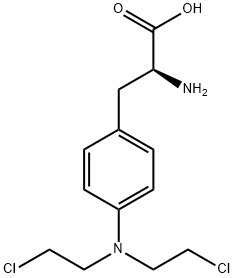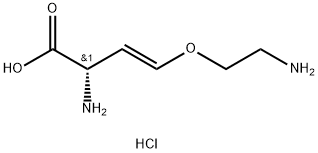A6034012
MELPHALAN , 90% , 148-82-3
Synonym(s):
L -PAM;L -Phenylalanine mustard;4-[Bis(2-chloroethyl)amino]-L -phenylalanine
CAS NO.:148-82-3
Empirical Formula: C13H18Cl2N2O2
Molecular Weight: 305.2
MDL number: MFCD00057717
EINECS: 205-726-3
Update time: 2022-07-08
PRODUCT Properties
| Melting point: | ~180 °C |
| Boiling point: | 473.1±45.0 °C(Predicted) |
| alpha | D25 +7.5° (c = 1.33 in 1.0N HCl); D22 -31.5° (c = 0.67 in methanol) |
| Density | 1.3587 (rough estimate) |
| refractive index | 1.6070 (estimate) |
| storage temp. | -20°C Freezer |
| solubility | 95% ethanol and 1 drop 6 N HCl: 0.05 g/mL, clear |
| form | powder |
| pka | pKa 1.42/2.75/9.17(H2O,t =37.0,I=0.5) (Uncertain) |
| color | white |
| Water Solubility | <0.1 g/100 mL at 22 ºC |
| Merck | 13,5850 |
| BRN | 2816456 |
| InChIKey | SGDBTWWWUNNDEQ-LBPRGKRZSA-N |
| CAS DataBase Reference | 148-82-3(CAS DataBase Reference) |
| IARC | 1 (Vol. 9, Sup 7, 100A) 2012 |
| EPA Substance Registry System | Melphalan (148-82-3) |
Description and Uses
Melphalan is a nitrogen mustard derivative of the large neutral amino acid L-phenylalanine. It was first synthesized in 1953 by Bergel and Stock and is the active L-isomer of the compound. The D-isomer, known as medphalan, is less active against certain animal tumors, and the dose needed to produce effects on chromosomes is larger than that required with the L-isomer. The racemic (DL-) form is known as merphalan or sarcolysin.
antineoplastic, alkylating agent
Safety
| Symbol(GHS) |   GHS06,GHS08 |
| Signal word | Danger |
| Hazard statements | H300-H317-H340-H350-H361 |
| Precautionary statements | P201-P280-P301+P310+P330-P302+P352 |
| Hazard Codes | T+ |
| Risk Statements | 45-46-26/27/28-63-36/38-62 |
| Safety Statements | 53-22-36/37/39-45 |
| RIDADR | UN 2811 6.1/PG 2 |
| WGK Germany | 3 |
| RTECS | AY3675000 |
| F | 8 |
| HazardClass | 6.1(a) |
| PackingGroup | II |
| HS Code | 29224999 |
| Hazardous Substances Data | 148-82-3(Hazardous Substances Data) |
| Toxicity | LD50 i.p. in rats: 14.7 mmol/kg (Ross) |



